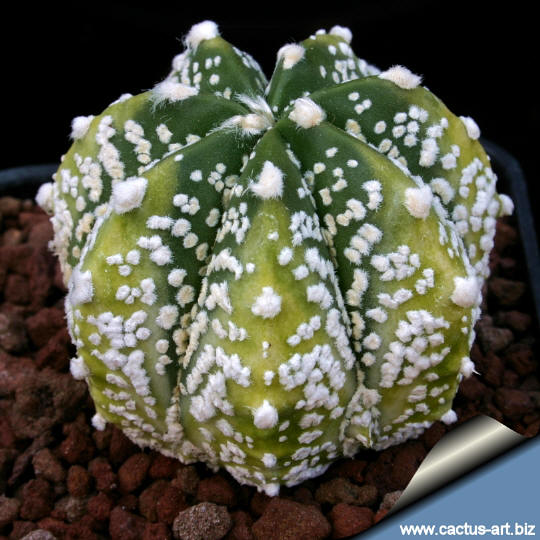|

Variegation, albinism &
schizochromism.
Variegation: A variegated plant has sectors, patches or stripes
with two or more different colours, even distinct shades of green.
Plants with variegated stems or leaves are often
attractive and
highly prized.
In most species the
stems or leaves are normally green, and variegated epidermis is an
uncommon
mutation, termed a
chimera. A chimeral variegation is due to losing the ability to
produce
chlorophyll in some of the plant’s
tissue, so that this tissue is no longer green. Tissues lacking
chlorophyll are usually white or pale yellow-coloured (due to
carotenoid
pigments) or red (due to
betalain or
anthocyanin pigments) contrasting with the normal green tissue.
There are several forms of variegation, depending on the tissues that
have been affected. The variegation in some forms is unstable. The
extent and nature of the variegation can vary, and sometimes the plant
will return to the green form. In others it is stable and does not
change under normal conditions. Because the variegation is due to the
presence of two kinds of plant tissue, propagating the plant must be by
a
vegetative method of
propagation that preserves both types of tissue in relation to each
other.
Albinism: Every once in a while a plant exhibits
albinism (completely lacking chlorophyll pigment). This
means that its tissue is unable to carry out photosynthesis. The
result is a completely cream-white plant. This plant will be weaker than
a green plant, and albinism is generally a fatal trait (it can't produce
its own food and it's not getting it from anywhere else). Without
chlorophyll, the albino plant has no way to manufacture the food needed
for survival and growth to maturity. This implies that these plants
cannot survive on their own roots and necessitate being grafted on a
normal green plant that provides food. Some of these albino plants are
indeed very popular, and sought after by collectors.
Schizochromism: The yellow or red appearance of some plants is
more precisely caused by another aberration called "schizochromism".
Here, though, the specific green pigment (chlorophyll) is missing: every
other pigment is present at normal levels. The dominant green
colouration is lost, but the plant will still more than likely have
normal other pigments that give the yellow overall appearance of stems
and the red colouration of spines. Cultivation:
Variegated cacti are regarded as choice and difficult in cultivation,
but despite that many
of them are
relatively easy to grow. But be aware that
they cannot tolerate prolonged exposure to direct sun light (especially
during the hottest summer days), so grow them in half-shade or
under filtered sun. They are sometime seen as grafted plants, but
many grow well on their own roots, too.
On the contrary,
the albinos can survive only if grafted on a strong green base.
Use mineral well-permeable substratum with little organic matter (peat, humus). Water
sparingly from
March till October and keep perfectly dry in
winter
at temperatures from 5 to 15 degrees centigrade.
(In general these plants are more tender and cannot endure
freezing temperatures
) In
the rest period no high atmospheric humidity!!
Propagation: Almost usually by seed. Plants are often
grafted onto column-shaped cacti.
|